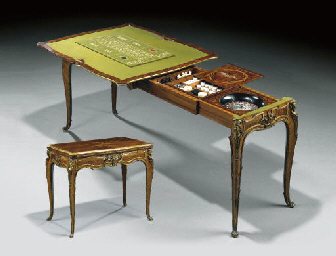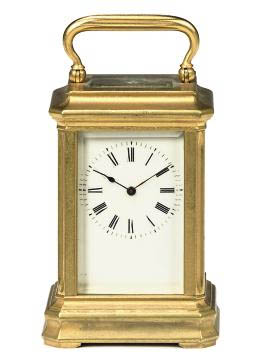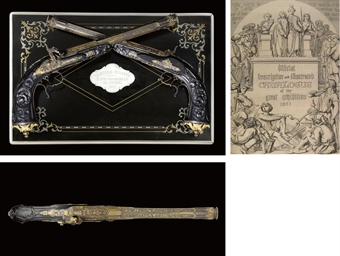Y A RARE FRENCH LOUIS XV BOULLE BRACKET TIMEPIECE HENRY SULLY, SAINT GERMAIN EN LAYE, CIRCA 1725 The single going barrel movement with verge escapement regulated by disc bob pendulum and rectangular plates incorporating canted lower angle united by four baluster pillars pinned at the rear, the backplate engraved Sully a St. Germain en Laye above the external mainspring barrel click, the 6 inch circular gilt brass twelve-piece enamel Roman numeral cartouche dial with Ho-Ho bird and lambrequin inhabited scroll-decorated centre within blue-on-white Roman hour numerals within rococo borders and with every minute numbered to outer track, with sculpted blued steel hands the engraved cut brass and brown shell marquetry decorated case with seated martial putto surmount to the domed caddy superstructure veneered with leafy scroll decoration and applied with foliate mounts to angles over swan neck centred crest flanked by rosettes, the front with brass-framed arched glazed door enclosing marquetry decorated 'tiled; floor and contra-parti veneered back panel to interior and incorporating cast panel featuring Ho-Ho birds grappling to apron, the surround decorated with leafy scrolls within line edging, the sides with scroll inlaid outswept upper sections terminating in batons applied with gilt swags over brass-edged windows with canted upper angles and arched lower rail over further laurel cast mounts to inlaid lower margins, on feet cast as dolphins with foliate scroll decorated apron between, (the movement previously with silent-pull repeat mechanism). 58.5cm (23ins) high, 28cm (11ins) wide, 16.5cm (6.5ins) wide. Henry Sully was born in 1680 and was apprenticed to Charles Gretton gaining his Freedom of the Clockmaker's Company in 1705. After a short period working as a journeyman for his former Master he left for Continental Europe first to Leiden 1708-11 then to Frankfurt and Vienna before settling in Paris in 1715. Whilst in Vienna he published his first book 'Regle Artificielle du Temps' in 1714 with the first French version subsequently published in Paris in 1717. It was at this time he formed a close working relationship with Pierre LeRoy and presented his first 'Montre de Mer' to the Academie des Sciences in 1716. In 1718 he established a watchmaking factory at Versailles before setting-up another in Saint Germain en Laye in around 1724. During his time in St. Germain Sully continued developing his designs for a Longitude timekeeper and in 1726 one of his timepieces (utilising his modified version of Debaufre's escapement with two diamond pallets) was trialled off Bordeaux. Henry Sully unfortunately died in 1728 bringing his efforts to further develop his Longitude timekeeper to an abrupt halt; if he had lived longer it is possible that he could have devised an appropriate timepiece well in advance of Harrison's 'H4' of 1759. Surviving clocks and watches by Henry Sully are very rare; the current lot is probably the only 'domestic' timepiece by him to survive from his time at St. Germain en Laye.
Y A RARE FRENCH LOUIS XV BOULLE BRACKET TIMEPIECE HENRY SULLY, SAINT GERMAIN EN LAYE, CIRCA 1725 The single going barrel movement with verge escapement regulated by disc bob pendulum and rectangular plates incorporating canted lower angle united by four baluster pillars pinned at the rear, the backplate engraved Sully a St. Germain en Laye above the external mainspring barrel click, the 6 inch circular gilt brass twelve-piece enamel Roman numeral cartouche dial with Ho-Ho bird and lambrequin inhabited scroll-decorated centre within blue-on-white Roman hour numerals within rococo borders and with every minute numbered to outer track, with sculpted blued steel hands the engraved cut brass and brown shell marquetry decorated case with seated martial putto surmount to the domed caddy superstructure veneered with leafy scroll decoration and applied with foliate mounts to angles over swan neck centred crest flanked by rosettes, the front with brass-framed arched glazed door enclosing marquetry decorated 'tiled; floor and contra-parti veneered back panel to interior and incorporating cast panel featuring Ho-Ho birds grappling to apron, the surround decorated with leafy scrolls within line edging, the sides with scroll inlaid outswept upper sections terminating in batons applied with gilt swags over brass-edged windows with canted upper angles and arched lower rail over further laurel cast mounts to inlaid lower margins, on feet cast as dolphins with foliate scroll decorated apron between, (the movement previously with silent-pull repeat mechanism). 58.5cm (23ins) high, 28cm (11ins) wide, 16.5cm (6.5ins) wide. Henry Sully was born in 1680 and was apprenticed to Charles Gretton gaining his Freedom of the Clockmaker's Company in 1705. After a short period working as a journeyman for his former Master he left for Continental Europe first to Leiden 1708-11 then to Frankfurt and Vienna before settling in Paris in 1715. Whilst in Vienna he published his first book 'Regle Artificielle du Temps' in 1714 with the first French version subsequently published in Paris in 1717. It was at this time he formed a close working relationship with Pierre LeRoy and presented his first 'Montre de Mer' to the Academie des Sciences in 1716. In 1718 he established a watchmaking factory at Versailles before setting-up another in Saint Germain en Laye in around 1724. During his time in St. Germain Sully continued developing his designs for a Longitude timekeeper and in 1726 one of his timepieces (utilising his modified version of Debaufre's escapement with two diamond pallets) was trialled off Bordeaux. Henry Sully unfortunately died in 1728 bringing his efforts to further develop his Longitude timekeeper to an abrupt halt; if he had lived longer it is possible that he could have devised an appropriate timepiece well in advance of Harrison's 'H4' of 1759. Surviving clocks and watches by Henry Sully are very rare; the current lot is probably the only 'domestic' timepiece by him to survive from his time at St. Germain en Laye.















Testen Sie LotSearch und seine Premium-Features 7 Tage - ohne Kosten!
Lassen Sie sich automatisch über neue Objekte in kommenden Auktionen benachrichtigen.
Suchauftrag anlegen